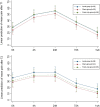Supplemental vibrational force does not reduce pain experience during initial alignment with fixed orthodontic appliances: a multicenter randomized clinical trial
- PMID: 26610843
- PMCID: PMC4661602
- DOI: 10.1038/srep17224
Supplemental vibrational force does not reduce pain experience during initial alignment with fixed orthodontic appliances: a multicenter randomized clinical trial
Abstract
This prospective randomized trial investigated the effect of supplemental vibrational force on orthodontic pain during alignment with fixed-appliances. Eighty-one subjects < 20 years-old undergoing extraction-based fixed-appliance treatment were randomly allocated to supplementary (20-minutes/day) use of an intra-oral vibrational device (AcceleDent(®)) (n = 29); an identical non-functional (sham) device (n = 25) or fixed-appliances only (n = 27). Each subject recorded pain intensity (using a 100-mm visual-analogue scale) and intake of oral analgesia in a questionnaire, following appliance-placement (T1) and first-adjustment (T2) for 1-week (immediately-after, 4, 24, 72-hours and at 1-week). Mean maximum-pain for the total sample was 72.96 mm [SD 21.59; 95%CI 68.19-77.74 mm] with no significant differences among groups (P = 0.282). Subjects taking analgesics reported slightly higher maximum-pain although this was not significant (P = 0.170). The effect of intervention was independent of analgesia (P = 0.883). At T1 and T2, a statistically and clinically significant increase in mean pain was seen at 4 and 24-hours, declining at 72-hours and becoming insignificant at 1-week. For mean alignment-rate, pain-intensity and use of analgesics, no significant differences existed between groups (P > 0.003). The only significant predictor for mean pain was time. Use of an AcceleDent vibrational device had no significant effect on orthodontic pain or analgesia consumption during initial alignment with fixed appliances.
Figures



References
-
- Kvam E., Bondevik O. & Gjerdet N. R. Traumatic ulcers and pain in adults during orthodontic treatment. Comm Dent Oral Epidemiol 17, 154–157 (1989). - PubMed
-
- Scheurer P. A., Firestone A. R. & Burgin W. B. Perception of pain as a result of orthodontic treatment with fixed appliances. Eur J Orthod 18, 349–357 (1996). - PubMed
-
- Johal A., Fleming P. S. & Al Jawad F. A. A prospective longitudinal controlled assessment of pain experience and oral health-related quality of life in adolescents undergoing fixed appliance treatment. Orthod Craniofacial Res 17, 178–186 (2014). - PubMed
-
- Jones M. & Chan C. The pain and discomfort experienced during orthodontic treatment: a randomized controlled clinical trial of two initial aligning arch wires. Am J Orthod Dentofacial Orthop 102, 373–381 (1992). - PubMed
Publication types
MeSH terms
Substances
LinkOut - more resources
Full Text Sources
Other Literature Sources
Medical

